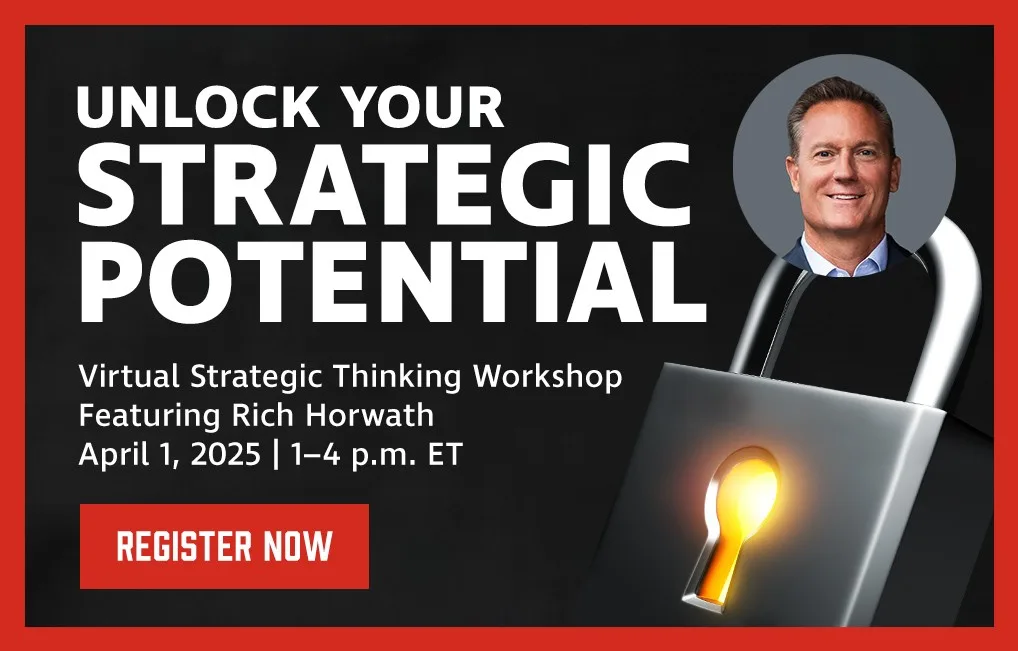“The lion does not turn around when a small dog barks.” African Proverb
A hallmark trait of elite performers in business, sports, science, war, and the arts is the discipline to remain focused on the important and not become distracted by the trivial. Being overly reactive to market trends, competitor actions, and one-off customer requests can become a pattern of behavior embedded within a company’s culture causing executives to lose sight of the big picture. A study by consulting firm PwC of more than 6,000 corporate executives found that 63% said their company does NOT have clear strategic direction on where they are headed. Of those who did believe their organization had a clear strategy, only 35% said it would enable them to win in their market.

During the past two decades facilitating strategic thinking and planning workshops with executive teams to guide their strategy development, I’ve seen what separates the elite from the rest of the pack. Following are ten areas you can use as a checklist to help your executive team outthink and outperform the competition:
1. Strategic Decision Making.
A key factor in unlocking greater organizational performance is getting clear on who owns what decisions. I begin this process by leading executive teams through a Decision Inventory to identify the top recurring decisions, level of importance, current owner, and future owner. Once decision rights are established, we introduce tools to trigger more effective and frequent delegation which in turn leads to greater decision velocity throughout the organization.
2. Reallocation of Resources.
If your executive team is only reallocating people, time, and capital once a year during the planning process, you are not operating at an elite level. Executive teams should be thoughtfully reallocating resources on a monthly basis. I developed a simple trade-off exercise to give executive teams a forum to discuss where, why, and how resources should be reallocated, and it stimulates highly engaging dialogue that leads to substantive change.
3. Meeting Governance.
With the average manager spending more than 21 hours per week in meetings, it’s important for the executive team to take a more hands-on approach to ensuring that time is invested effectively and efficiently. I recommend leaders score their meetings for one month based on value and then perform a meeting audit where we specify each meeting’s purpose, frequency, time frame, attendee list, and recommendations for improvement. Meeting checklists for both the leaders and participants provide a detailed guide to best practices to ensure they are being used to share and act on insights, and not a forum for a single leader to talk at people like they’re delivering a late night talk show monologue.
4. Business Model Evolution.
Your business model can be summarized as how your company creates, delivers, and captures value. An intriguing exercise I lead in strategy workshops is to identify the current state for each of those areas and then seed the team with techniques to ideate on what they could potentially do in the future to innovate. It’s critical that the executive team invests time discussing the future state of the business (transform) and not spend all of their time working on today’s business (perform). How much time is your executive team consistently devoting to discussing the future state of the business? If it’s less than 20 percent, your company will likely not be around in 10 years.
5. Competitive Awareness.
I recently led a strategy workshop for a highly experienced executive team where a leader commented at the close: “I learned more about our competition during that 20-minute exercise than I have in the past six years.” When I refer to competitive awareness, I’m not talking about the competitor’s products, services, and geographic footprint. The focus here is on the elements that are foundational to their competitive position in the market: core competencies, capabilities, activities, target customer, messaging, resource allocation, and strategies. How well does your executive team know the building blocks of your competition’s strategy?
6. Customer Value.
To determine how well your executive team understands the true drivers of customer value in your business, pass out a 3×5 notecard at your next meeting and ask everyone to write down the value proposition for your most important offering. The value proposition should address the target customer, the customer’s primary need or job to be done, how you fulfill those needs in a unique way, and the benefits of the offering. Then map out your business value chain which illustrates the handful of primary activities the company uses to deliver the offering’s value proposition. In order to take your business to the next level of profitable growth, you’ll need to evolve both the internal (value chain) and external (value proposition) nexus of value.
7. Organizational Alignment.
High performance occurs when an executive team has intentionally aligned their strategy, structure, and culture. Too often, these building blocks are developed, sculpted, and polished with little to no recognition of how they fit with and support one another. I’ve seen organizations embark on an aggressive sales and marketing product launch campaign but have a culture built on risk-aversion because failure is historically punished. Or big change management initiatives that swallow large gulps of time and money but fall flat because the executive team fails to delegate decisions that should be owned elsewhere. Combine your conversations on strategy, structure, and culture and you’ll prevent the disconnects that can derail your progress.
8. Intentional Collaboration.
One of the biggest opportunities most organizations have to significantly improve their results requires zero additional resources but a little thoughtful reflection. Every functional area has internal or external customers they serve. How often are the people in these groups proactively meeting with these colleagues to understand new perspectives and needs? In my experience, it’s rarely intentional and most often reactive when problems arise. Executive teams should create accountability for a
consistent cadence of collaboration between the appropriate groups and individuals so that new value is being created on a continuous basis.
9. Insight Accountability.
Strategy and innovation are both built on insight. I define an insight as a learning that leads to new value. The highest functioning executive teams create accountability from their people to proactively share 3-5 insights each month that have led to new value for the business. These insights are then shared within and across functions, levels, and business units to create a flywheel of learning that produces higher engagement, greater productivity, and increased innovation. As an example, a significant contributor to technology innovator Nvidia’s smashing success has been CEO Jensen Huang’s requirement that leaders regularly share via email their top 5 insights regarding the things they are working on.
10. Board Interaction.
Beware the executive team that spends more time preparing for board meetings than running their business. While the interaction between the senior team and board of directors is important for both groups, it would benefit from less scripted presentations and more dynamic dialogue. This enables the executive team to dramatically reduce the number of hours in preparation but instead focuses a much smaller percentage of overall time on crafting insight-generating questions for the group to discuss. Transform board presentations to conversations to maximize the expertise of both groups.
The primary role of an executive team is to set strategic direction for the business and ensure resources are allocated and aligned to realize the strategy. The ten traits outlined provide a roadmap for executive teams to excel in their role. Is your team behaving like the king of the jungle or constantly yapping at the small stuff?
STRATEGIC Thinking & Planning to Maximize Your Leadership Performance
Tuesday, April 1, 2025 1 – 4 p.m. ET
(Noon – 3 p.m. CST | 10 a.m. – 1 p.m. PT)Join Rich Horwath — New York Times & Wall Street Journal bestselling author of 8 books on strategy — in a highly interactive 3-hour workshop to gain new knowledge, skills, and tools to think, plan, and act strategically.


